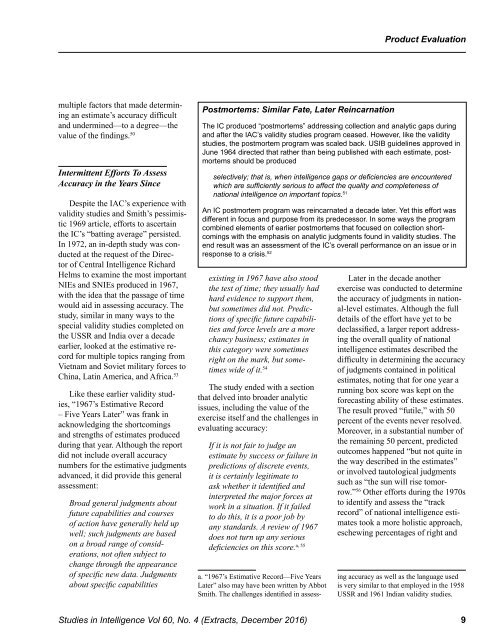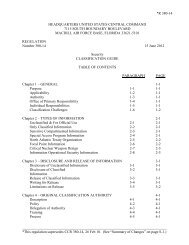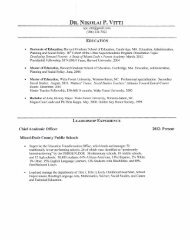extracts-studies-dec-2016
extracts-studies-dec-2016
extracts-studies-dec-2016
Create successful ePaper yourself
Turn your PDF publications into a flip-book with our unique Google optimized e-Paper software.
<br />
Product Evaluation<br />
multiple factors that made determining<br />
an estimate’s accuracy difficult<br />
and undermined—to a degree—the<br />
value of the findings. 50<br />
Intermittent Efforts To Assess<br />
Accuracy in the Years Since<br />
Despite the IAC’s experience with<br />
validity <strong>studies</strong> and Smith’s pessimistic<br />
1969 article, efforts to ascertain<br />
the IC’s “batting average” persisted.<br />
In 1972, an in-depth study was conducted<br />
at the request of the Director<br />
of Central Intelligence Richard<br />
Helms to examine the most important<br />
NIEs and SNIEs produced in 1967,<br />
with the idea that the passage of time<br />
would aid in assessing accuracy. The<br />
study, similar in many ways to the<br />
special validity <strong>studies</strong> completed on<br />
the USSR and India over a <strong>dec</strong>ade<br />
earlier, looked at the estimative record<br />
for multiple topics ranging from<br />
Vietnam and Soviet military forces to<br />
China, Latin America, and Africa. 53<br />
Like these earlier validity <strong>studies</strong>,<br />
“1967’s Estimative Record<br />
– Five Years Later” was frank in<br />
acknowledging the shortcomings<br />
and strengths of estimates produced<br />
during that year. Although the report<br />
did not include overall accuracy<br />
numbers for the estimative judgments<br />
advanced, it did provide this general<br />
assessment:<br />
Broad general judgments about<br />
future capabilities and courses<br />
of action have generally held up<br />
well; such judgments are based<br />
on a broad range of considerations,<br />
not often subject to<br />
change through the appearance<br />
of specific new data. Judgments<br />
about specific capabilities<br />
Postmortems: Similar Fate, Later Reincarnation<br />
The IC produced “postmortems” addressing collection and analytic gaps during<br />
and after the IAC’s validity <strong>studies</strong> program ceased. However, like the validity<br />
<strong>studies</strong>, the postmortem program was scaled back. USIB guidelines approved in<br />
June 1964 directed that rather than being published with each estimate, postmortems<br />
should be produced<br />
selectively; that is, when intelligence gaps or deficiencies are encountered<br />
which are sufficiently serious to affect the quality and completeness of<br />
national intelligence on important topics. 51<br />
An IC postmortem program was reincarnated a <strong>dec</strong>ade later. Yet this effort was<br />
different in focus and purpose from its pre<strong>dec</strong>essor. In some ways the program<br />
combined elements of earlier postmortems that focused on collection shortcomings<br />
with the emphasis on analytic judgments found in validity <strong>studies</strong>. The<br />
end result was an assessment of the IC’s overall performance on an issue or in<br />
response to a crisis. 52<br />
existing in 1967 have also stood<br />
the test of time; they usually had<br />
hard evidence to support them,<br />
but sometimes did not. Predictions<br />
of specific future capabilities<br />
and force levels are a more<br />
chancy business; estimates in<br />
this category were sometimes<br />
right on the mark, but sometimes<br />
wide of it. 54<br />
The study ended with a section<br />
that delved into broader analytic<br />
issues, including the value of the<br />
exercise itself and the challenges in<br />
evaluating accuracy:<br />
If it is not fair to judge an<br />
estimate by success or failure in<br />
predictions of discrete events,<br />
it is certainly legitimate to<br />
ask whether it identified and<br />
interpreted the major forces at<br />
work in a situation. If it failed<br />
to do this, it is a poor job by<br />
any standards. A review of 1967<br />
does not turn up any serious<br />
a, 55<br />
deficiencies on this score.<br />
a. “1967’s Estimative Record—Five Years<br />
Later” also may have been written by Abbot<br />
Smith. The challenges identified in assess-<br />
Later in the <strong>dec</strong>ade another<br />
exercise was conducted to determine<br />
the accuracy of judgments in national-level<br />
estimates. Although the full<br />
details of the effort have yet to be<br />
<strong>dec</strong>lassified, a larger report addressing<br />
the overall quality of national<br />
intelligence estimates described the<br />
difficulty in determining the accuracy<br />
of judgments contained in political<br />
estimates, noting that for one year a<br />
running box score was kept on the<br />
forecasting ability of these estimates.<br />
The result proved “futile,” with 50<br />
percent of the events never resolved.<br />
Moreover, in a substantial number of<br />
the remaining 50 percent, predicted<br />
outcomes happened “but not quite in<br />
the way described in the estimates”<br />
or involved tautological judgments<br />
such as “the sun will rise tomorrow.”<br />
56 Other efforts during the 1970s<br />
to identify and assess the “track<br />
record” of national intelligence estimates<br />
took a more holistic approach,<br />
eschewing percentages of right and<br />
ing accuracy as well as the language used<br />
is very similar to that employed in the 1958<br />
USSR and 1961 Indian validity <strong>studies</strong>.<br />
Studies in Intelligence Vol 60, No. 4 (Extracts, December <strong>2016</strong>) 9




